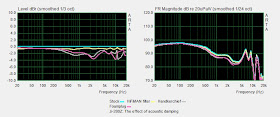Beats by Dre Powerbeats, Brookstone Clear Dual-Drive JI-280Z, and Radius HP-TWF22 share one common feature: A double driver with the exact same specification.
Manufacturered by a well-known ODM company in Asia, this driver, also known as Double Driver Matrix, is a coaxial dynamic microtransducer with a ø7mm tweeter and a ø15mm woofer joined together by a crossover network on a same yolk. However, their magnetic systems, voice coils, and acoustic outputs are all separated in order to prevent any type of acoustic interference among the drivers from occurring. And by inverting the polarity of one of the magnets, both drivers remain in-phase with one another.
And in conjunction with an Italian DSP solution provider, Dirac, Radius comes up with a proprietary iOS application, Ne AUDIO, in order to further increase the fidelity of the IEM. According to the manufacturer, Ne AUDIO not only corrects the overall frequency response , but also helps damp any unwanted transient characteristic of the driver itself. Really?
PRO: Impressive electrical stability, low harmonic distortion, and open-air like soundstage.
CON: A sharp deep-null above 10 kHz, suggesting there is some sort of phase-cancellation involved between the drivers. Treble is slightly sibilant too.
ON SECOND THOUGHT #1: Neither Insertion depth nor electrical damping shall affect the sound of JI-280Z due to the anomalies in the high frequency range. On top of that, sleeve acoustics don't help much either.
ON SECOND THOUGHT #2: Extra acoustic resistance does not tame the peaks/deep-nulls in the treble. Rather, it decreases the woofer's mid-range sensitivity.
ON SECOND THOUGHT #3: Surprisingly, the rear vent only affects the mid range. Blocking the frontal vents shall increase the amount of bass, while pumping up the peak at 5 kHz at the same time.
ON SECOND THOUGHT #4: Considering Radius' official frequency response chart is a 2cc coupler(IEC 60318-5) data, of which RECD is not reflected in the result, it well corresponds to my analysis in 3rd octave resolution.
ON SECOND THOUGHT #5: The proprietary app, Radius Ne AUDIO, definitely changes the sound of the IEM, by bringing it closer to the diffuse field reference. Even some of the harshness are gone.
And buyers beware: As suspected, this app neither corrects nor optimizes the transient characteristic of the IEM.
And buyers beware: As suspected, this app neither corrects nor optimizes the transient characteristic of the IEM.
ON SECOND THOUGHT #6: To my surprise, the combination of Ne AUDIO(HP-TWF22 enabled), UE900 stock sleeves, and shallow insertion yield a great synergy effect to JI-280Z. With the help of Ne AUDIO's precise compensation and the reverse-horn effect derived from UE900 sleeves most of the harshness will effectively be removed. As a result, the overall tonality actually becomes very close to that of Dr. Sean Olive's hi-fidelity target, with the bandwidth now easily reaching 20 kHz.















How does the Olive target look without the app?
ReplyDeleteHere you go!
Deletehttp://2.bp.blogspot.com/-1WazimnSWT8/UetVE2Eof1I/AAAAAAAAHnc/ca5OtSY340I/s320/owow.jpg
does right ear sleeves compensate the null above 10khz??
ReplyDeleteA reverse-horn bore somehow helps, but Ne AUDIO is still vital.
Delete